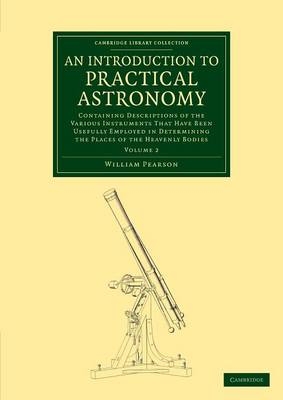
An Introduction to Practical Astronomy: Volume 2
Cambridge University Press (Verlag)
978-1-108-06406-4 (ISBN)
Although astronomical guides were available in the early nineteenth century, they tended to come from continental presses and were rarely in English. This two-volume work by the clergyman and astronomer William Pearson (1767–1847) aimed, with brilliant success, to compile data from extant sources into one of the first English practical guides to astronomy. Most of the tables were updated and improved versions, and some were wholly reconstructed to streamline the calculation processes. Sir John Herschel dubbed it 'one of the most important and extensive works on that subject which has ever issued from the press', and for his efforts Pearson was awarded the gold medal of the Astronomical Society. First published in 1829, Volume 2 provides full descriptions of a range of astronomical instruments, alongside instructions for their use and some pertinent equations and tables. In the history of science, Pearson's work reflects the contemporary challenges of celestial study.
1. Preliminary remarks; 2. On the situation, structure, and furniture of an observatory; 3. Rotative dome; 4. Refracting telescopes with celestial eye-pieces; 5. Diagonal eye-pieces; 6. Celestial eye-pieces with variable powers; 7. Erect eye-pieces; 8. A popular explanation of the achromatism of the refracting telescope; 9. Stands for achromatic telescopes; 10. Equatorial or parallatic stands; 11. The construction and use of the dynameter; 12. The Dorpat refracting telescope; 13. On reflecting telescopes; 14. Stands for reflecting telescopes; 15. The Herschelian forty feet reflector; 16. Herschelian telescope as constructed by Ramage; 17. On the space-penetrating powers of telescopes; 18. An historical account of the different methods of measuring small celestial arcs; 19. Spider's-line micrometer; 20. Other methods of determining the value of a screw; 21. Micrometrical scale with a constant magnifying power; 22. On the different methods of illuminating the lines in the eye-piece of a telescope; 23. A new polymetric reticle; 24. Reticulated diaphragms; 25. Circular and annular micrometers; 26. La Caille's method; 27. Smeaton's method; 28. Dollond's object-glass micrometer; 29. Experimental determination of the focal length and errors of a divided object-lens; 30. Dollond's improved object-glass micrometer; 31. Dioptric micrometers; 32. Dioptric micrometer by T. Jones; 33. The divided eye-lens micrometer; 34. Ramsden's catoptric micrometer; 35. Dr Maskylene's prismatic micrometer; 36. The cuneiform micrometer; 37. Rochon's crystal micrometer; 38. Methods of determining the constant angle of a doubly refracting prism of rock crystal; 39. The ocular crystal micrometer; 40. The spherical crystal micrometer; 41. Brewster's micrometrical telescope; 42. The lamp-micrometer; 43. Binocular spider's-line and glass-disc micrometers; 44. On the use of position micrometers; 45. Comparison of several micrometers; 46. On clamps and tangent screws; 47. On the vernier; 48. On the reading microscope; 49. On the plumb-line; 50. On the spirit-level; 51. On artificial horizons; 52. On Flamsteed's and La Caile's methods of observing; 53. On the transit clock; 54. The transit instrument; 55. A portable transit-instrument; 56. Directions for the examination and adjustment of a transit-instrument; 57. To determine the exact place for a meridian mark; 58. On the errors of the transit-instrument in connexion with a clock or chronometer; 59. The Moscow transit-instrument; 60. The Greenwich transit-instrument; 61. Observing and registering transits; 62. Reduction of observed transits into mean right ascensions; 63. On the correction of right ascension common to all stars; 64. Transit-circle by Troughton; 65. Reduction of the apparent zenith distance to the mean polar distance; 66. Ramsden's altitude and azimuth circular instrument; 67. The Westbury altitude and azimuth circle; 68. The South Kilworth altitude and azimuth circle; 69. The collimator; 70. On the uses of a portable altitude and azimuth circular instrument; 71. A new portable altitude, azimuth and zenith instrument; 72. The Greenwich mural circle; Chs. 72-104; Plates.
| Erscheint lt. Verlag | 5.9.2013 |
|---|---|
| Reihe/Serie | Cambridge Library Collection - Astronomy |
| Zusatzinfo | 31 Plates, black and white; 20 Line drawings, unspecified |
| Verlagsort | Cambridge |
| Sprache | englisch |
| Maße | 210 x 297 mm |
| Gewicht | 1830 g |
| Themenwelt | Sachbuch/Ratgeber ► Natur / Technik ► Weltraum / Astronomie |
| Naturwissenschaften ► Physik / Astronomie ► Astronomie / Astrophysik | |
| ISBN-10 | 1-108-06406-X / 110806406X |
| ISBN-13 | 978-1-108-06406-4 / 9781108064064 |
| Zustand | Neuware |
| Haben Sie eine Frage zum Produkt? |
aus dem Bereich


